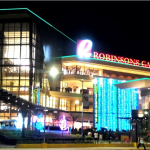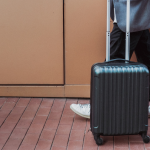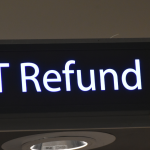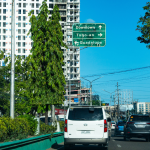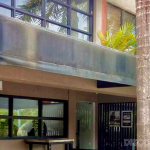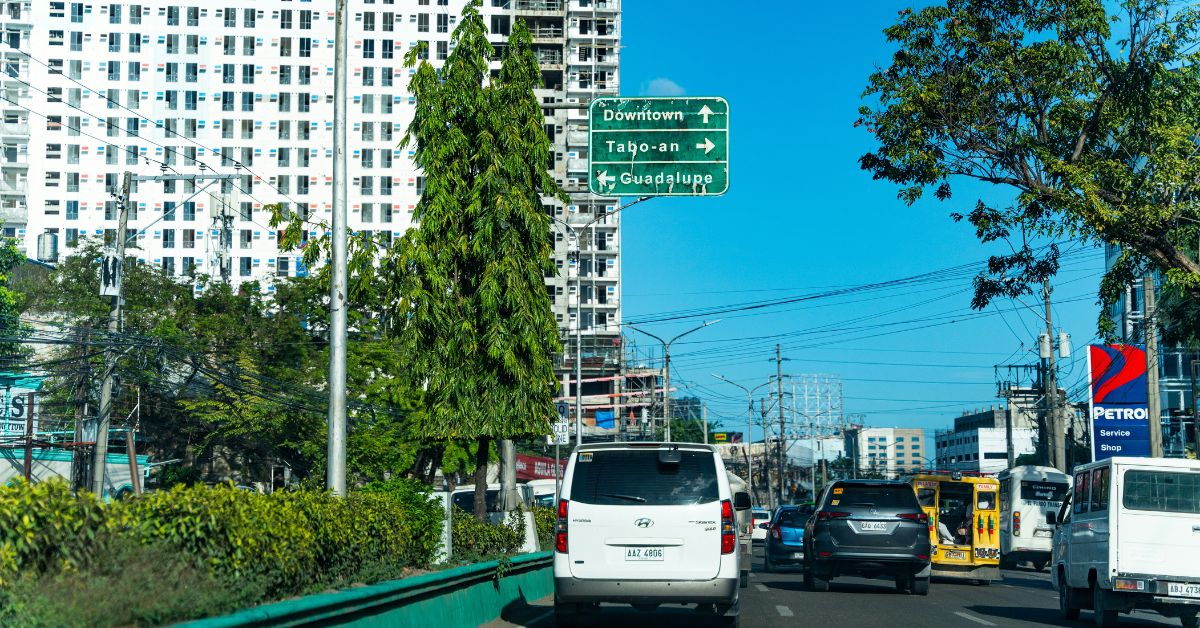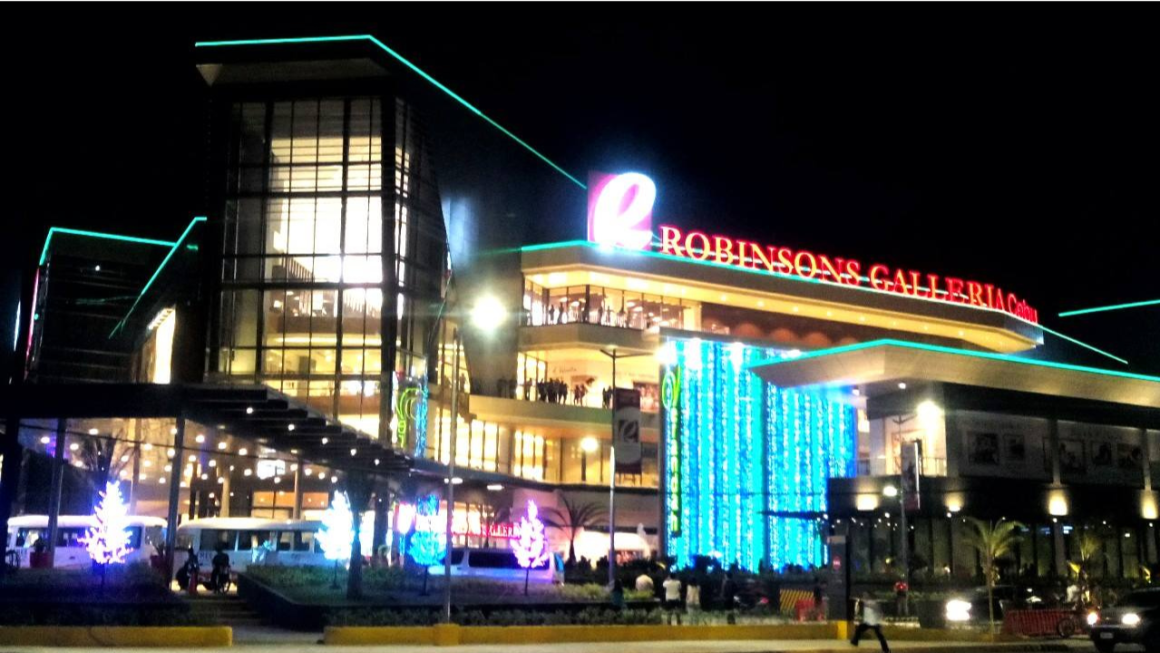Let’s streamline your getting around Cebu City game with tech hacks, safety tips, and a side of Cebuano survival phrases.
I’m not Adèle Blanc-Sec.
I’m that slightly disheveled woman juggling a laptop bag, travel mug, and a confused look that screams “I thought Google Maps said turn left?” I’m also a digital nomad, which means Cebu City is both my office and my playground.
Getting around Cebu City isn’t always as smooth as a flat white, but hey, mishaps make for good stories, right? (And sometimes, for finding the coolest hidden café). Because here’s the thing: Cebu’s transport system is a glorious, chaotic puzzle. Think jeepneys bursting with color, beeping taxis, and an occasional air-conditioned bus that feels like winning the travel lottery. It’s enough to send your inner control freak into a minor panic attack.
But panic no more, fellow nomad! I’ve navigated this urban jungle fueled by caffeine and sheer stubbornness. Let me be your slightly less lost guide. Consider this your crash course in navigating Cebu like a pro. We’ll cover everything from deciphering jeepney routes to finding those heavenly wifi-equipped oases. Think of it as the digital nomad’s survival kit: part tech-savvy, part practical, with a dash of street smarts.
If you’re ready to ditch the overwhelm and embrace the adventure of Cebu’s streets, buckle up. Let’s make those “lost” moments the start of something cool, one hilariously confusing Angkas ride at a time.
Where the HECK Are We Going? Mapping Out Cebu
Let’s get some bearings before diving into the glorious mess of getting around Cebu City. You’re probably picturing island life – swaying palms, white sand, the whole bit. And yeah, Cebu has that in spades, but for our purposes, we’re focusing on the urban jungle of Cebu City. Day trips to those tropical paradises are on the future itinerary, but for now, it’s about conquering the city streets.
Now, about those neighborhoods. If you’re wired like me, with a constant craving for caffeine and a solid wifi connection, then IT Park is your mecca. This is the tech heart of the city, buzzing with startups, software companies, and enough coffee shops to keep you fueled for a month. Then there’s Fuente Osmeña, the classic downtown, full of history and that energetic “big city” pulse. Uphill, we find Lahug, which offers a slightly more upscale vibe, with views to boot. As to where to base yourself… well, that’s a mix of your work style, budget, and tolerance for karaoke (no judgment here, some nights it just hits the spot).
Speaking of finding your way, let’s talk about Cebuano street names. Think of it like a scavenger hunt designed by a history buff with a flair for the dramatic. You’ll see names of national heroes, Spanish conquistadores, and Catholic saints all tossed together. It’s honestly quite fascinating but about as practical for navigation as trying to read Tolkien’s Elvish on the back of a speeding jeepney. Don’t worry, though; we’ll crack the code together. There’s a method to this organized chaos, I promise.
The OG Transport: Walking, Cebu-Style
Walking is the most sustainable, low-tech way of getting around Cebu City. But before you lace up your sneakers and romanticize those European strolls, we’ve got to talk about Cebu-style pedestrian life.
Safety-wise, it’s like most cities: generally fine during daylight hours, but needs more smarts as the sun goes down. Stick to well-lit, populated routes – think malls connecting to main boulevards, not dimly lit backstreets. Common sense for a solo woman traveler anywhere, right? Daytime Cebu has its quirks though. Those sidewalks…or what passes for them? Expect a slalom course of vendors selling everything from mangoes to phone chargers, the occasional open manhole (watch your step!), and maybe a snoozing stray doggo or two. Think of it as agility training fueled by street food smells.
Speaking of smells, Cebu equals HEAT. And by heat, I mean that sweat-slicked, frizzy-hair-but-still-smiling kind. Breathable fabrics are your BFF. Think linen, not leather. Sunscreen is non-negotiable, and a chic little hand fan brings a touch of old-world glamour while keeping you sane on the sidewalk. Want that Zoom-call-ready look post-walk? A stash of wet wipes and a mini deodorant in your tote will save the day. Remember, it’s not about looking perfect, it’s about rocking that confident “I’ve just navigated Cebu City on foot” glow.
Jeepney Journeys: If You Dare
Strap in, because we’re about to go full-on Cebu with the iconic jeepney. Think of these babies as rolling fiestas on wheels – a riot of colors, chrome, and sometimes even karaoke, crammed with locals, students, and the occasional chicken… you get the picture. But beneath the joyous chaos, there’s a system, and I’m here to help you crack the code so you can ride like a seasoned pro.
First, let’s address the elephant in the room, or rather, the flamboyantly painted mini-bus barreling down the road. Jeepneys are an ingenious Filipino creation, born of necessity when surplus WWII Willys Jeeps were repurposed for public transport. Today, they’re a lifeline of affordable transit, but they’re also a crash course in Cebuano culture if you’re up for a little organized mayhem.
To navigate those swirling routes, look for those destinations painted proudly on the side. Think of it as the ultimate low-tech signage. You’ll need some basic Cebuano like “lugar lang” (just here), or the all-purpose “para!” to signal a stop. Don’t be shy about asking fellow passengers – most Cebuanos are friendly, and might be amused by the adventurous foreigner giving the jeepney a go. Oh, and unspoken jeepney etiquette? Prepare to squeeze in. Those benches are designed for maximum capacity, so get cozy with your neighbor.
Now, the fare. Forget tapping a card – we’re going old-school with coins and small bills. You’ll then embark upon the Olympic sport that is passing your fare along a chain of passengers saying, “Palihug (please)” until it reaches the front. It’s a testament to Cebuano kindness and honesty (mostly!), and let’s be real, kinda fun once you get the hang of it.
Think of a jeepney journey as sustainable travel with a healthy dose of adrenaline. It won’t always be efficient, air-conditioned, or entirely comfortable, but it’s the best way to experience the pulse of Cebu City, and who knows? You might just make some new friends along the way.
Here are some of the jeepney routes within Ayala – SM City – IT Park
- 04L – IT Park to SM City Mall (passing Ayala Center Mall)
- 04M – Lahug to JY Square Mall (passing Ayala Center )
- 17B/ 17D – Apas, IT Park, Lahug to Carbon market
- 17C – Apas, IT Park to Caron via Gen. Maxilom Ave.
- 03Q – Mabolo to SM City (passing Ayala Center)
- 20A/ 20B – Mandaue City to Ayala Center via Mabolo
- 12L – Labangon to Ayala
- 12G – Labangon to SM City
- 14D – Ayala Mall to Colon (via Escario, Fuente, F. Ramos St./ return trip via Fuente Jones to Capitol)
- 13C – Talamban, Ayala to Colon
- 13B – Talamban, Ayala to Carbon via Ramos
- 62B/62C – Pit-os, Ayala to Carbon
Here are some of the jeepney routes within Cebu City:
- 03A/ 03L – Mabolo to Colon
- 03B – Mabolo to Colon (passing Mango Avenue, Fuente Circle, Jones)
- 03Q – Mabolo to SM City (passing Ayala Center)
- 01K – Urgello to Colon, North Bus Terminal, Park Mall
- 06B – Guadalupe to Colon via Capitol and Jones Ave.
- 07B – Banawa to Colon via Capitol and Jones Ave.
- 02B – South Bus Terminal to Pier area
- 12D – Labangon to Colon
- 21A/ 21D – Mandaue City to Manalili to Cebu Cathedral
- 22I – Mandaue City to Gaisano Country Mall via A.S. Fortuna Street
- 24 – going to Consolacion
- 25 – going to Liloan/Danao
Fare: Php 13 minimum
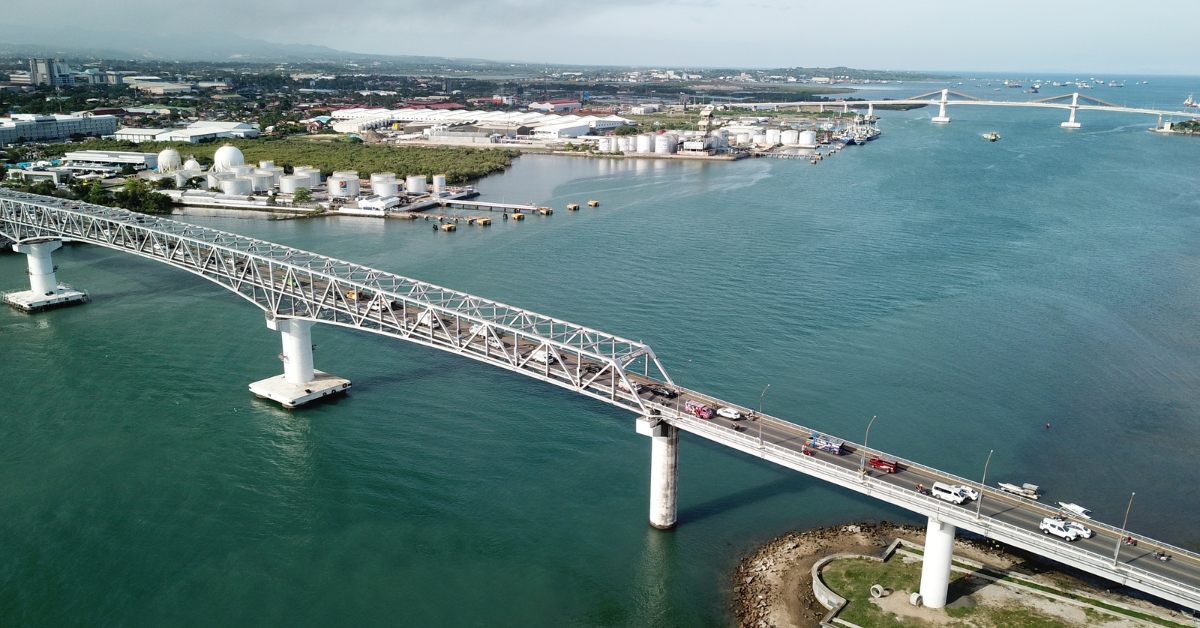
Beep and MyBus: Cebu’s (Kinda) Modern Buses
The sight of a jeepney hurtling down a Cebu street never quite loses its charm (or its ability to induce a bit of heart-pounding terror). But sometimes, a girl needs aircon and a guaranteed seat. That’s where BEEPs and MyBus come in.
BEEP
“Beep” is a total double whammy here: it stands for “Bus-Jeep Enhanced Engine Program,” the fancy name for those modernized bus-jeepney hybrids. Plus, it refers to the beep card payment method – goodbye fumbling with coins! There are a bunch of these plying routes around Cebu City, all sleek and blue (or white, depending on their capacity).
The good stuff? Full air conditioning, onboard cameras for a sense of security, and those little TVs that usually blast Filipino game shows. It’s a smoother ride than the jeepney, and a bit more planet-conscious.
As of November 2019, there are only three routes available:
1. Cebu City Hall – Asia Town, I.T. Park
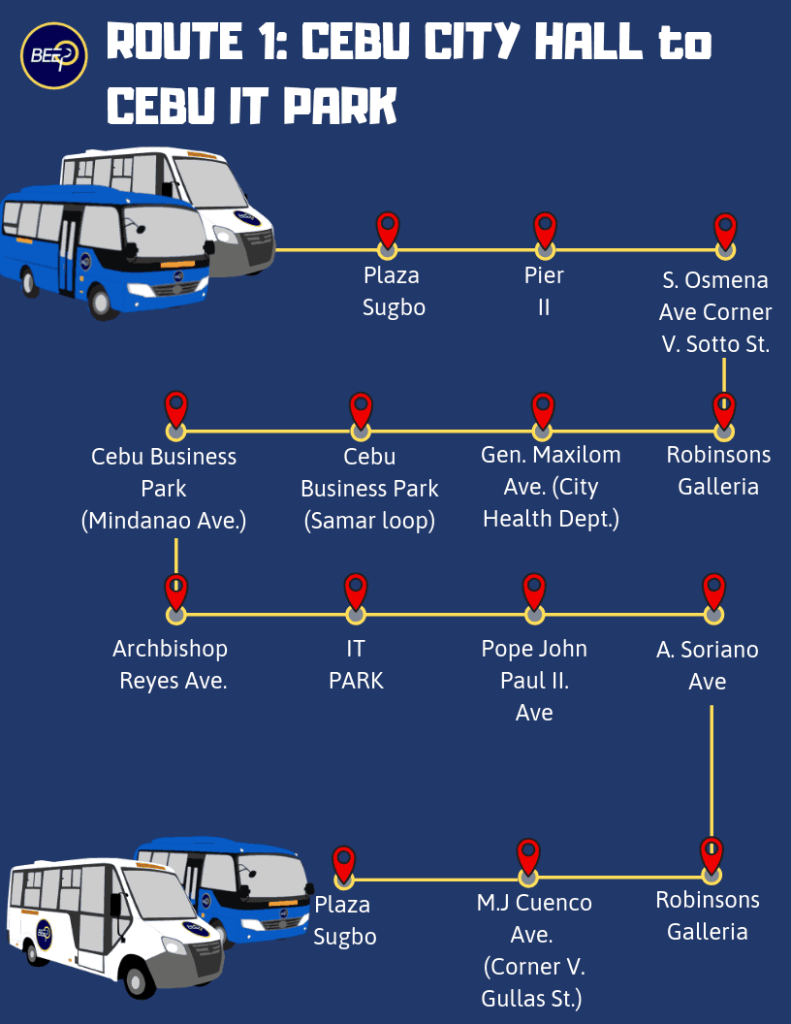
2. Paseo Arcenas Banawa (R. Duterte St.) – Sykes Panagdait
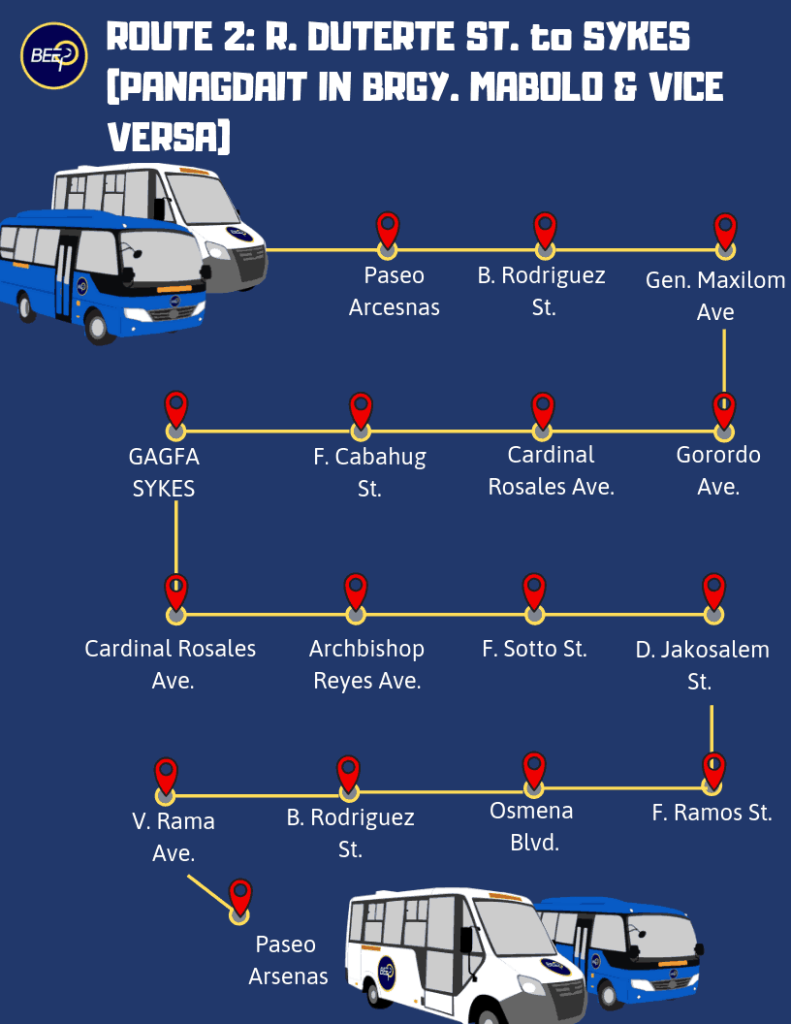
3. Guadalupe to Carbon market
- Guadalupe -> Capitol -> Jones Ave. -> Downtown Cebu (vice versa)
PeoplesJeep
PeoplesJeep is new kid on the block. Launched in 2019, PeoplesJeep are essentially BEEP buses, but with a cooperative ownership model. They feel like those fancy mini-buses you see in airports, shrunk down for Cebuano streets. Same perks as BEEP apply, with possibly more consistent routes since they’re focused on specific areas.
Currently, PeoplesJeep follow four routes:
- Talamban – Ayala – Colon
- Lahug – Ayala – SM
- Bulacao – Colon – SM
- Talamban – Colon (following the 13C route)
Fare: Php 15 minimum
MyBus
MyBus serves a slightly different purpose. These bigger guys are best for specific journeys – think airport to SM Seaside mall, or between the major transport terminals. They also have that fancy ePLUS card for cashless payment.
SM City Cebu – Airport (vice versa)


SRP to Parkmall, Mandaue and Vice Versa

Fuente – SM Sea Side and Vice Versa
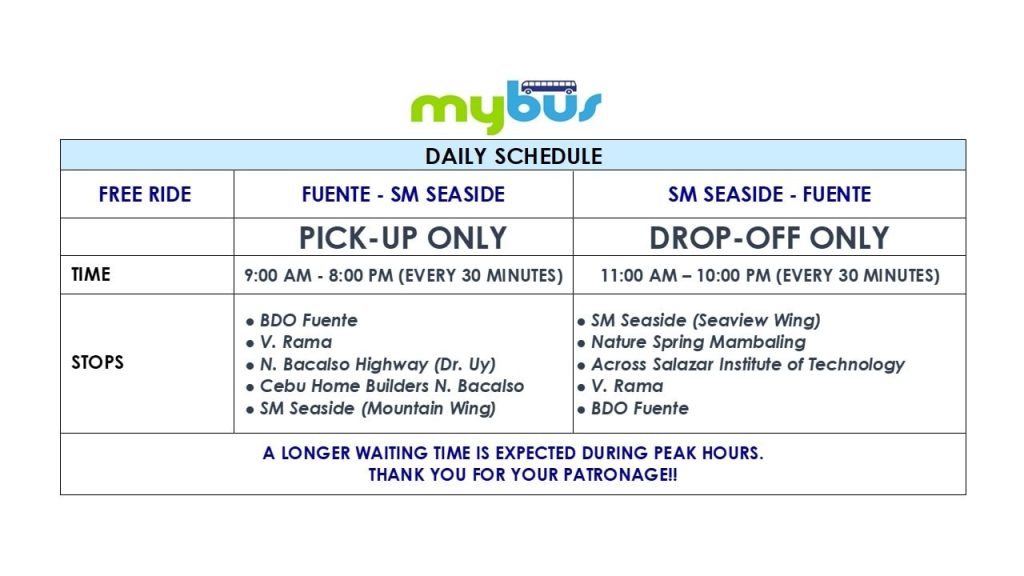
MyBus Cebu Bus Stations

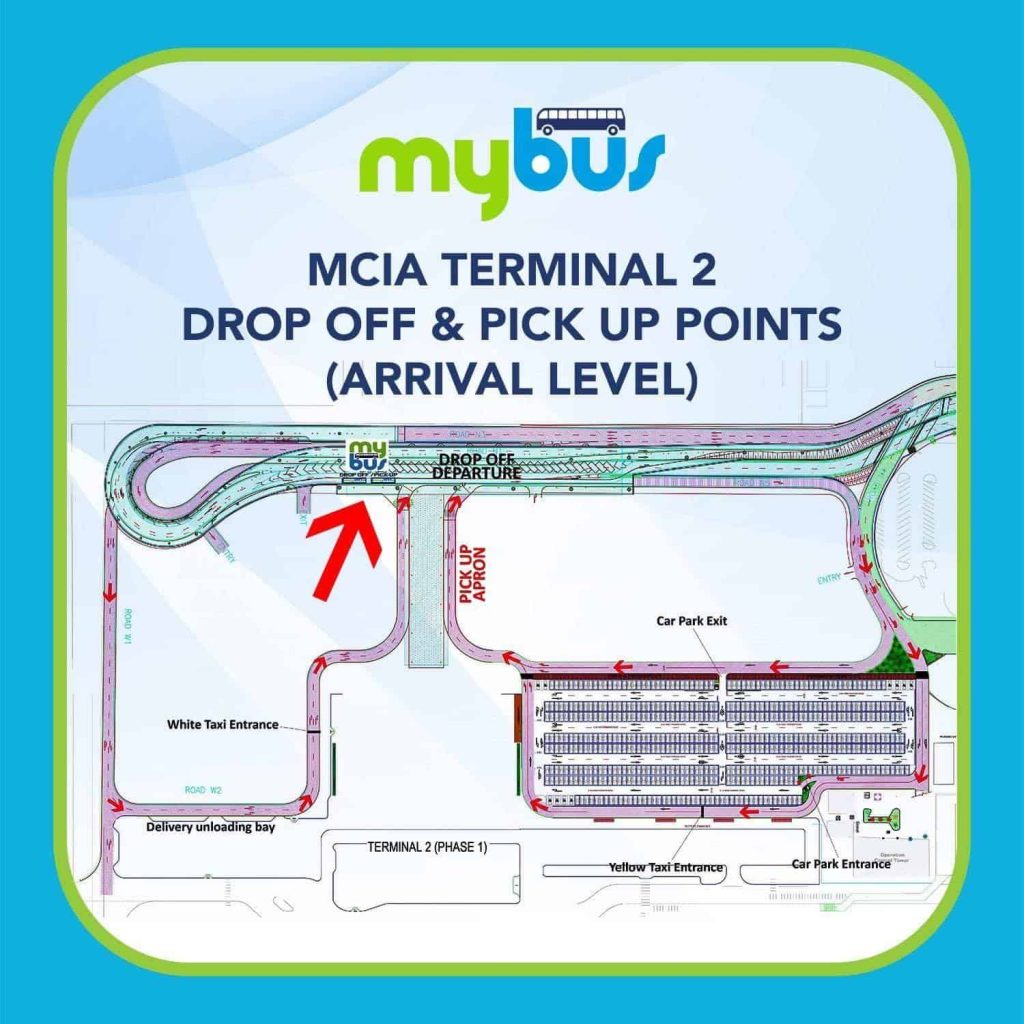
If you want to familiarize the streets of Cebu, this is the most convenient means. But if your schedule is tight, choose another conveyance.
How to Beep (and MyBus) Right
- Routes are King/Queen. Before hopping on, check the signage for the bus routes. Currently, BEEPs have limited routes compared to jeepneys, so they won’t take you everywhere in Cebu City. Think of them as a step up in comfort when your route happens to match.
- Stations, Not Hailing. Unlike jeepneys, these guys have designated stops. Keep an eye out, or you might miss your chance to disembark in a flurry of panicked button-pressing.
- Fares. Beep fares start at around PHP 9.50, which is a bit steeper than a jeepney. MyBus has varying fees depending on the route. Think of it like paying for that aircon privilege, okay?
My Verdict
Want to sightsee and soak in the Cebu street vibe? MyBus on the N. Bacalso – BDO Fuente route is a good bet. Tight schedule and desperately need to NOT arrive a sweaty mess? Opt for a taxi or ride-hailing app. But when you want that middle ground between colorful jeepney chaos and the convenience of Grab, the BEEP network can be your jam.
Taxis and Ride-Hailing: Trading Chaos for Convenience
Sometimes, a girl just needs a comfy seat and working AC. Especially after braving a few jeepney rides, the familiar world of taxis and ride-hailing apps offers a comforting hit of predictability when getting around Cebu City. Of course, they come with their quirks.
White Taxi Cabs
Similar to the yellow taxis, but sometimes operate on a fixed price rather than a meter. Do your homework beforehand if you have a specific destination in mind. You can bargain, but it takes practice and a little bit of Cebuano wouldn’t hurt.
White taxi fare: Php 40 (USD .77) flag-down rate + Php 13.50 for every succeeding kilometre and Php 2 per minute of waiting time in traffic
Grab is Your Friend
Think of the Grab app as your personal chauffeur service on demand. Sure, “surge pricing” during rush hour can sting, but sometimes paying a bit extra for that sweet air conditioning and the knowledge of exactly where you’re going is downright priceless. Bonus? You can track your ride, minimizing those awkward “Where are you now?” calls on unfamiliar streets.
Yellow Cabs: When They Work, They’re Fine
Yellow cabs are the OG Cebu transport option. They’re plentiful, and hailing one gives you that classic “I’m in a movie!” moment. The catch? Not all drivers are created equal. Some are honest, while others might try to “creatively” interpret the meter (remember those language skills!). It’s a bit of a gamble, but asking locals or your hotel for reliable cab companies can up your odds of a smooth ride.
Yellow taxi fare: Php 70 (USD 1.35) + P4 for every succeeding 300 meters
Women-Driven Options
There’s debate around this, and it touches on bigger issues of safety in public transport (a whole other blog post!). Some companies or smaller networks do offer women-driven options, aimed at providing a bit more peace of mind for solo female travelers. I’m digging into finding reputable services right now because that extra layer of comfort matters.
My Verdict
Taxis and ride-hailing won’t replace the cultural experience of jeepneys, and they’re not the most sustainable choice. But hey, we work hard – sometimes a private, climate-controlled ride with a dash of WiFi is the best form of self-care.
Safety tips: Always lock the door once you’ve boarded. There have been incidents when robbers would randomly open taxi doors when traffic is at standstill. Also, check that the meter is running. There’s also a newly reported scam where the driver intentionally forgets to turn on the meter so they can charge a higher than usual fare later.
Getting Off The Beaten Path: Sustainable-ish Escapes
Alright, let’s dive into the wild side of Cebuano transport! Think less luxury coach tour, and more “Indiana Jones with a latte” vibes. Because when that wanderlust kicks in and Cebu City starts feeling a little *too* urban, we nomads crave those off-the-grid adventures. Luckily, options abound – though “sustainable-ish” is the key phrase here.
Habal-Habal Adventures: Embrace the Adrenaline (and Sketchiness)
Imagine clinging to the back of a motorcycle, whipping through mountain roads, views that’ll hijack your Instagram feed. That’s the habal-habal experience. It’s fast, it’s cheap-ish (if you’re a haggling pro), and exhilarating… with a side of safety concerns. It’s the transport equivalent of that street food that’s SO good, but you might regret it later.
These guys are lifesavers for getting to waterfalls, remote beaches, etc. But know this: no helmets (usually), your driver might be 16, and the ‘road rules’ are… flexible. Think of it as a calculated risk for that epic photo-op.
As written in our habal-habal guide, here are the fares for the usual routes within Metro Cebu:
- Ayala to I.T. Park – P30 ($0.57)
- Maria Luisa Road to I.T. Park – P70 ($1.33)
- I.T. Park to SM City – P70 ($1.33)
- Ayala to SM Seaside – P120 – P150 ($2.3 – $2.8)
V-Hire Vans: Cultural Immersion, Sardine-Style
Craving a dose of authentic Cebuano life? Hop on a V-hire! These shared vans cram in as many passengers as humanly possible. You’ll be elbow-to-elbow with locals, groceries, and maybe a live chicken… it’s loud, sweaty, and an experience you won’t forget.
Bonus points: It’s dirt cheap for longer hauls to nearby towns. But bring snacks, because stopping is unpredictable. Like that overstuffed suitcase you should’ve unpacked, it’s all part of the journey.
Bike Rentals: Cebu’s (Questionable) Cycling Scene
Cebu has bike rentals… but the city itself? Not ideal. Traffic is chaotic, and bike lanes are rare. Think twice before pedaling through downtown. However, there ARE quieter areas for scenic rides (check out online cycling groups for tips).
So, it’s not like bike-friendly Copenhagen, but doable if you’re smart about routes. A mountain bike opens up more remote possibilities, too.
Angkas: The ‘Grab’ of Motorcycle Taxis
If habal-habal bargaining stresses you out, Angkas is your friend. This app lets you hail a motorcycle ride (with a helmet, yay for safety!), and fares are fixed upfront. Think of it as Uber but with more wind-in-your-hair excitement.
Ferries: Your Scenic Sea Shortcut
Need a Mactan Island escape? Ferries across the channel are fast, and breezy, and offer stunning skyline views. Way more charming than a taxi in traffic, and eco-friendlier too.
A ferry departs every 10-20 minutes in Pier 3 bound for Lapu-lapu City.
If you’re coming from Mactan Island, here’s where you can take a ferry boat:
Topline Express Ferry
At Mactan Marina Mall, walk towards Island City Mactan where the ferry terminal is located. The Island Ferry 1 that will take you to Pier 3 in downtown Cebu City. It’s a 30-minute ride coast-to-coast – add to that the time spent buying tickets. Daily route is from 5 am to 9 pm.
Fare: Php 25-30 ($0.48 to $0.57)
Metro Ferry
Go to the Muelle Osmena port near Opon Mercado. Buy your ticket and pay the terminal fee. Metro Ferry will take you to Pier 3 in just 15-20 minutes.
Fare: Php 14 ($0.27) + Php 2 (terminal fee).
Sea Jeepney
From southern Cebu, commuters can now travel to Cebu City onboard the MyBoat “sea jeepney.” The vessel sails from Naga City port to Pier 1 and vice versa for a total of 10 trips daily. Each trip takes 45-60 minutes coast to coast.
MyBoat schedule is as follows:
- Heading to Cebu City:
- 5:30 am
- 7:50 am
- 10:10 am
- 2:10 pm
- 4:30 pm
- From Cebu City:
- 6:40 am
- 9 am
- 1 pm
- 3:20 pm
- 5:40 pm.
Fare: Php 60
Beyond the Basics: Niche Transport Wins
- Tricycles. Cebu’s version of a tuk-tuk, these covered trikes are perfect for short hops within neighborhoods. Unlike habal-habals, tricycles have a roof which makes them useful on extremely hot or rainy days. You can get one to take you to the nearest bus/jeep station or to rural locations. Tricycles can carry up to 4 passengers at a time. They usually wait for other passengers to ensure full capacity, but you can offer to pay the full-capacity price (pakyaw) if you’re in a rush.
- Renting Your Ride. If driving doesn’t scare you, motorbike or car rentals unlock serious freedom. Proceed with caution – think of it as playing Frogger with real-life consequences. There are peer-to-peer motorbike sharing services like Book2wheel and Rentmotorcebu.com that let you rent on a daily, weekly, monthly basis. They usually offer delivery and pick-up for free. Rental prices start at Php 350 (daily), Php 2450 (weekly), and Php 6500 (monthly). You can find a lot of car rentals with a quick Facebook or Google search. Be sure to check the reviews to get the best possible service. Hourly rates within Cebu average Php 850 + Php 300 for every succeeding hour, while daily rates average Php 4500.
Getting around Cebu City is an adventure in itself. Embrace the chaos a little, trust your gut, and always have backup caffeine on hand. That ‘lost and kinda loving it’ moment? That’s where the best stories start.
Tech to the Rescue: Apps That Save Your Sanity
Time to unleash your inner tech goddess! I know navigating a new city can feel overwhelming, especially in Cebu City where the streets sometimes seem to have a mind of their own. But fear not, because I’m about to arm you with digital tools that’ll help you conquer this urban maze.
Google Maps, Your Trusty Sidekick
Okay, we all know Google Maps. It’s like the trusty compass of our digital age. But here’s the thing: Google Maps in Cebu deserves its masterclass. Let’s unlock those lesser-known superpowers:
- Offline Savior. Spotty internet is the bane of every nomad. Before venturing out, download offline maps of Cebu. Trust me, this is your lifeline when the wifi gods betray you. It’s like a cached treasure map for navigating those moments of signal darkness.
- Hidden Gems. Google Maps isn’t just about routes. Search cafes, coworking spaces, and even those hole-in-the-wall eateries your fellow nomads rave about. Tap the “Explore” tab and unleash your inner digital Magellan!
Waze for the Traffic Win?
Think of Waze as your personal traffic whisperer. It taps into the wisdom (and occasional grumbling) of fellow drivers to paint a real-time picture of traffic jams, accidents, and those sneaky shortcuts. Here’s how to use Waze with the savviness of a local:
- Eyes on the Prize. Waze is meant for pre-trip intel, not while driving (safety first!). Plan your route before you hit the road, keeping those little Waze icons in mind (they could mean potholes, speed traps, or even a random mango stand).
- Rush Hour Radar. Cebu traffic worsens at predictable times. Waze helps you outsmart the gridlock during peak periods, suggesting alternative routes even if they seem circuitous at first.
Like with any crowdsourced app, Waze relies on user input. Sometimes it’s incredibly accurate, other times a little less so. It’s a fantastic tool, but not an infallible oracle. Pair it with your gut instincts, and you’ll be dodging those traffic jams with ninja-like reflexes.
Extra Credit: Leveling Up Your Cebu Street Cred
Okay, you’ve mastered the jeepney, survived a Grab price surge, and (mostly) know where you’re going. Now, let’s go from a newbie digital nomad to a seasoned Cebuana traveler. Because getting around Cebu City is one thing, but thriving in it? That’s a whole different skill set.
Rainy Day Retreats: Because It WILL Rain
Cebu’s got that tropical charm, which means sun…and sometimes a whole lotta downpour. Here’s your wet-weather survival kit:
- Coffee + Wifi Havens. Bo’s Coffee (local chain, everywhere!), Abaca Baking Company (those pastries, tho), and Coffee Factory (if you’re in IT Park).
- When Only AC Will Do. Malls are your overly chilled sanctuary. Ayala Center Cebu and SM City Cebu are classics, SM Seaside is the fancy schmancy option.
Cebuano 101: Transport Edition
Knowing a few keywords makes all the difference. No, you won’t be fluent overnight (unless you’re secretly a linguistic genius), but these get you by:
- “Para!” (Stop!). Yell this LOUDLY when you want the jeepney to pull over.
- “Bayad!” (Payment!). Hand this to the driver along with your fare, with a smile if you can manage.
- “Asa dapit and…?” (Where is…?). Best followed by pointing and looking hopeful.
- “Tabang!” (Help!). When things get real. A last resort, but good to know.
Lost in Translation: What To Do When Panic Sets In
It happens to the best of us. Maps fail, batteries die, and suddenly you’re on a street corner feeling VERY far from home. Let’s troubleshoot:
- Who to Ask. Security guards (they’re everywhere), friendly-looking shop staff, or fellow young people (better chance of English).
- Breathe. Panic makes things worse. Remember, Cebuanos are generally kind folks, willing to help if they can.
- Power Bank = Lifeline. Dying phone + being lost is a recipe for a meltdown. Your backup battery saves the day.
- Embrace the Detour. Sometimes, getting lost is the BEST way to find hidden gems and unexpected adventures.
Think of this like a language-learning game, an upgraded version of charades with a Cebuano twist.
FAQs
It’s generally safe, but like any city, awareness is key. I stick to well-lit, populated areas at night, and I’ve learned a bit of self-defense… just in case a stray mango decides to challenge me.
I budget more for comforts than bare-bones backpacking, since good coffee and reliable WiFi are survival gear for me. Expect to spend more than Southeast Asia hotspots, but less than Western cities.
Depends on your heat tolerance and shoe choice! I walk short distances, but Cebu rewards those prepared for uneven sidewalks and the occasional tropical downpour.
Widely! Filipinos are amazing at English, even with that charming Cebuano accent. But I suggest learning basic Bisaya phrases – it breaks the ice and will help you navigate better.
It takes effort. I seek out refill stores, carry my reusables, and love exploring markets. But single-use plastic is still a reality here, so it’s about finding your balance.
Absolutely! Cebu’s cafe scene is booming. In a separate post, I’ll share my favorite work-friendly spots, where the coffee is strong and the WiFi is stronger. My go-to is Abaca Baking Company on the top floor of Ayala Center.
Grab for transport, Google Maps for life, and Gcash for cashless payments. Language apps are fun, but a smile and “salamat” (thank you) go a long way.
Coworking spaces, expat groups, even striking up conversations in cafes! Cebuanos are friendly, and if you’re like me, a slightly awkward introvert, a little effort goes a long way.
Cebu’s your launchpad for amazing beaches! I’ll cover ferry logistics, and how to find eco-conscious stays for those weekend escapes in the future.
Patience is key, as is a sense of humor. Things WILL go wrong, but that’s half the adventure, right? Besides, there’s always a strong coffee waiting around the corner.
Takeaway Message
So, did I conquer all your Cebu transit fears? Probably not. But hey, half the fun is in the figuring it out, right? Getting around Cebu City will always have some chaotic charm thrown in, no matter how much tech you try to throw at it. But that’s also what makes it memorable. I guarantee those near-misses with jeepneys and frantic moments of lost-in-translation will make the best stories later, told over a fantastic cup of Cebuano coffee.
And remember, as digital nomad women, we got this. We’re adaptable, resourceful, and caffeinated to the max. Cebu might throw some unexpected routes our way, but who says we have to follow a perfect map anyway? Sometimes the best adventures start when we ditch the itinerary and embrace the unknown.
And speaking of adventures, if you’re ready to ditch the tourist hotspots and dive deep into Cebu on a seriously shoestring budget, check out my guide on the Ultimate Cebu Itinerary: The Really Frugal Solo Traveler’s Guide.
Until then, maayong adlaw (that’s Cebuano for “good day”), and happy wandering!


